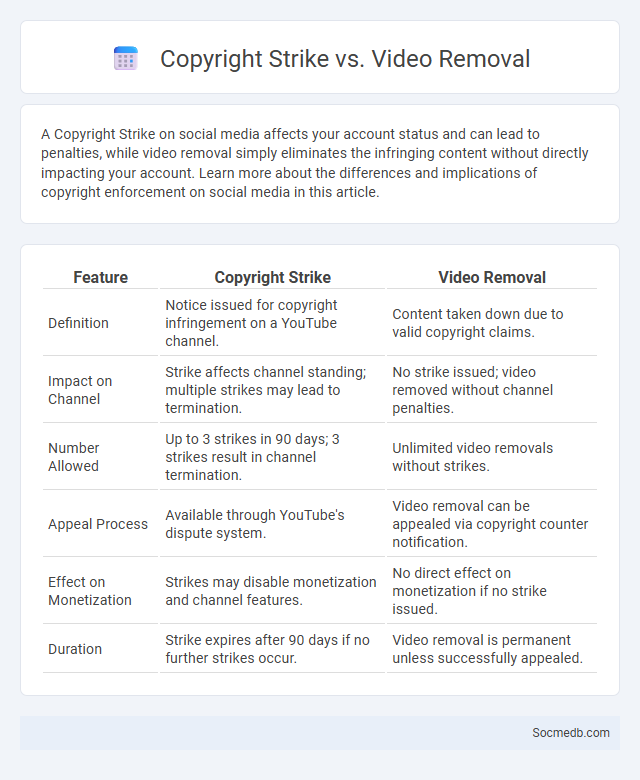
Photo illustration: Copyright Strike vs Video Removal
A Copyright Strike on social media affects your account status and can lead to penalties, while video removal simply eliminates the infringing content without directly impacting your account. Learn more about the differences and implications of copyright enforcement on social media in this article.
Table of Comparison
| Feature | Copyright Strike | Video Removal |
|---|---|---|
| Definition | Notice issued for copyright infringement on a YouTube channel. | Content taken down due to valid copyright claims. |
| Impact on Channel | Strike affects channel standing; multiple strikes may lead to termination. | No strike issued; video removed without channel penalties. |
| Number Allowed | Up to 3 strikes in 90 days; 3 strikes result in channel termination. | Unlimited video removals without strikes. |
| Appeal Process | Available through YouTube's dispute system. | Video removal can be appealed via copyright counter notification. |
| Effect on Monetization | Strikes may disable monetization and channel features. | No direct effect on monetization if no strike issued. |
| Duration | Strike expires after 90 days if no further strikes occur. | Video removal is permanent unless successfully appealed. |
Understanding Copyright Strikes: Definition and Impact
Copyright strikes on social media occur when protected content is used without permission, leading to content removal or account penalties. Understanding how these strikes affect your video visibility and channel status is essential for maintaining your social media presence. Protect your content by respecting copyright rules to avoid disruptions in Your account growth and engagement.
What Constitutes a Video Removal on Online Platforms?
Video removal on online platforms occurs when content violates community guidelines, copyright laws, or legal regulations, prompting platforms to take down the video. This process often involves automated detection systems or user reports leading to content review and, if necessary, deletion or restriction. Platforms like YouTube and Facebook enforce removal policies to maintain user safety and comply with legal obligations.
Copyright Strike vs Video Removal: Key Differences
A copyright strike is a formal warning issued by platforms like YouTube when copyrighted content is uploaded without permission, potentially leading to account restrictions or termination after multiple offenses. Video removal occurs when a platform takes down a specific video due to copyright infringement claims, but it may not immediately result in a strike against the channel owner. Understanding these key differences helps content creators manage risks and maintain compliance with copyright laws on social media.
How Copyright Strikes Affect Creators and Channels
Copyright strikes on social media platforms can significantly impact creators by restricting content visibility, reducing monetization opportunities, and potentially leading to channel suspension. Repeated copyright violations trigger algorithmic penalties that diminish audience reach and hinder growth. Protecting original work while navigating copyright policies is crucial for maintaining channel sustainability and creative freedom.
The Legal Basis for Copyright Strikes and Video Removals
Copyright strikes and video removals on social media are grounded in the Digital Millennium Copyright Act (DMCA), which protects the rights of content creators by enabling copyright holders to request takedown of infringing material. Platforms like YouTube and Facebook implement automated systems to detect and remove content that violates copyright, ensuring compliance with legal requirements. You should understand that repeated copyright strikes can lead to account suspension or termination, emphasizing the importance of respecting intellectual property rights.
Steps to Take After Receiving a Copyright Strike
After receiving a copyright strike on social media, review the platform's copyright policy to fully understand the violation and its implications. You should immediately remove or disable access to the infringing content to prevent further penalties. Consider submitting a counter-notification if you believe the strike was issued in error, while preparing to provide evidence supporting your claim.
Platform Policies on Copyright Enforcement
Platform policies on copyright enforcement are designed to protect original content creators by detecting and removing copyrighted material without proper authorization. You must understand these platforms' automated systems, like Content ID on YouTube or Facebook's Rights Manager, which monitor uploads for potential infringements. Violations can lead to content removal, account suspension, or legal consequences, emphasizing the importance of complying with platform-specific copyright rules.
Disputing a Copyright Strike: Process and Tips
Disputing a copyright strike on social media involves submitting a formal counter-notification that challenges the claim, often requiring specific details such as the original content ownership and a statement of good faith belief. Platforms like YouTube provide a structured process where users can appeal strikes through their copyright management tools, emphasizing accurate evidence to strengthen the dispute. Key tips include documenting original work, understanding fair use policies, and ensuring timely responses to prevent content removal or channel restrictions.
Preventing Copyright Strikes and Video Removals
Protecting your social media content from copyright strikes and video removals requires understanding platform policies and using original or properly licensed materials. Implement tools like Content ID systems and dispute processes to safeguard your videos. Regularly review your content for potential infringement risks to maintain your channel's integrity and avoid disruptions.
Frequently Asked Questions About Copyright Issues
Social media platforms face complex copyright issues as users frequently upload content without permission, raising concerns about infringement and fair use. Common questions include how to legally share copyrighted materials, the implications of copyright strikes, and the process for dispute resolution on platforms like YouTube or Instagram. Understanding Digital Millennium Copyright Act (DMCA) policies and the role of content ID systems is essential for both creators and users to protect intellectual property rights effectively.
 socmedb.com
socmedb.com